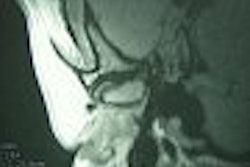NEW ORLEANS - Magnetic resonance imaging is definitely lagging behind other modalities in evaluating the coronaries, and in assessing valvular disease. But when it comes to other evaluations of the heart, the "gold standard" label now belongs to MRI.
In particular, cardiac MRI has already become the gold standard for assessing left ventricular size and function in acute myocardial infarction and chronic ischemic heart disease, and it's earning the mantle for determining myocardial viability as well.
That's the opinion of Dr. Christopher Kramer, director of cardiac MRI and associate professor of medicine and radiology at the University of Virginia Health System in Charlottesville. Kramer reviewed the evidence supporting his case in a special cardiac MRI symposium on Saturday at the American Heart Association (AHA) meeting.
Overall interest in cardiac MRI is clearly high: Several hundred attendees arrived a day early and paid an extra fee for the half-day overview prior to this year's AHA scientific sessions.
But while the session didn't overlook MRI's shortcomings -- such as its failure to top echocardiography for valvular disease, according to University of California, San Francisco radiologist Dr. Charles Higgins -- it did present an opportunity to summarize some striking successes.
"For viability, I submit that (MRI) is really becoming the gold standard because of its superior spatial resolution," Kramer said. "It's superior to SPECT; it's superior to PET."
"And the beauty of MR is that we have two distinct techniques: One very powerful technique for infarct detection -- delayed contrast enhancement -- and another very powerful technique that works best in subendocardial infarction for predicting recovery of function, and that's the contractile response to low-dose dobutamine."
Kramer reviewed a series of studies to bolster his contentions, many from researchers at Duke University in Durham, NC, and a few from Kramer's laboratory and colleagues at UVA.
One key to predicting recovery of function is a more accurate assessment of the actual damage, Kramer suggested, highlighting studies that show MRI's superior visualization of subendocardial infarction.
Among the studies was one published last year by researchers who examined 91 patients with delayed contrast-enhanced MR and with SPECT. In order to compare these imaging modalities to a gold standard, the group also acquired contrast-enhanced MR and SPECT images of 15 canine hearts with or without myocardial infarction, as defined by histochemical staining (The Lancet, February 1, 2003, Vol. 361:9355, pp. 374-379).
According to Kramer, 13% of the patients in the study had subendocardial infarction, yet had a normal SPECT exam.
"In a total of 181 segments with subendocardial infarction, in nearly half of them SPECT did not pick up the area of necrosis," Kramer said. "So delayed contrast-enhanced MR is much more sensitive."
Also thanks to the superior spatial resolution of MR, Kramer said, "we can now for the first time differentiate, by imaging, subendocardial from transmural myocardial infarction."
An MR technique for such differentiation has been perfected in the last few years with the development of the segmented inversion-recovery turboFLASH sequence published in 2001, Kramer said (Radiology, January 2001, Vol. 218:1, pp. 215-223).
PET's blunt assessments cannot reveal the gradations of prognosis that occur due to the inverse relationship between transmurality and the likelihood of recovery, Kramer suggested, while MR can.
MRI can also reveal areas of microvascular obstruction that are "very important prognostically," Kramer said.
In a study at UVA, "what we found is that if there's a segment with microvascular obstruction, that segment is truly dead. I mean really dead: there is absolutely no chance that that segment's going to recover," Kramer said.
Finally, when it comes to assessing the response to revascularization in ischemic heart disease, Kramer also cited recent studies in support of MRI.
In one study of 31 patients with ischemic left ventricular dysfunction, 11% of segments that PET deemed viable showed some hyperenhancement, generally from subendocardial infarction, on MRI (Circulation, January 2002, Vol. 15:105, pp. 162-167).
Low-dose dobutamine MR evaluations of contractile reserve appear to be an even better predictor than delayed contrast enhancement, Kramer added, citing several studies.
By Tracie L. Thompson
AuntMinnie.com staff writer
November 9, 2004
Related Reading
MRI touted for SPECT's role in sizing infarcts, August 4, 2004
PET may overpredict myocardial recovery compared with MRI, March 11, 2003
Cardiac MRI outdoes SPECT in spotting microinfarcts, February 14, 2003
MRI better than SPECT for predicting myocardial viability soon after MI, February 19, 2003
Stress test with SPECT remains main modality for assessing myocardial viability, November 8, 2002
Late-enhancement MRI compares to FDG-PET for gauging myocardial viability, August 26, 2002
Copyright © 2004 AuntMinnie.com


.fFmgij6Hin.png?auto=compress%2Cformat&fit=crop&h=100&q=70&w=100)





.fFmgij6Hin.png?auto=compress%2Cformat&fit=crop&h=167&q=70&w=250)











